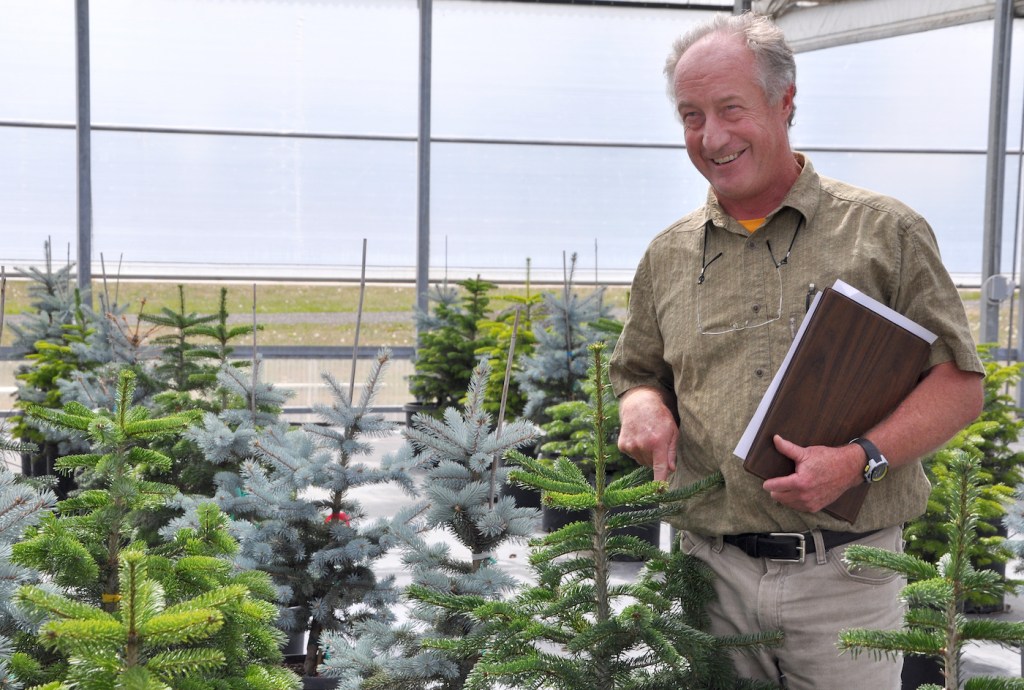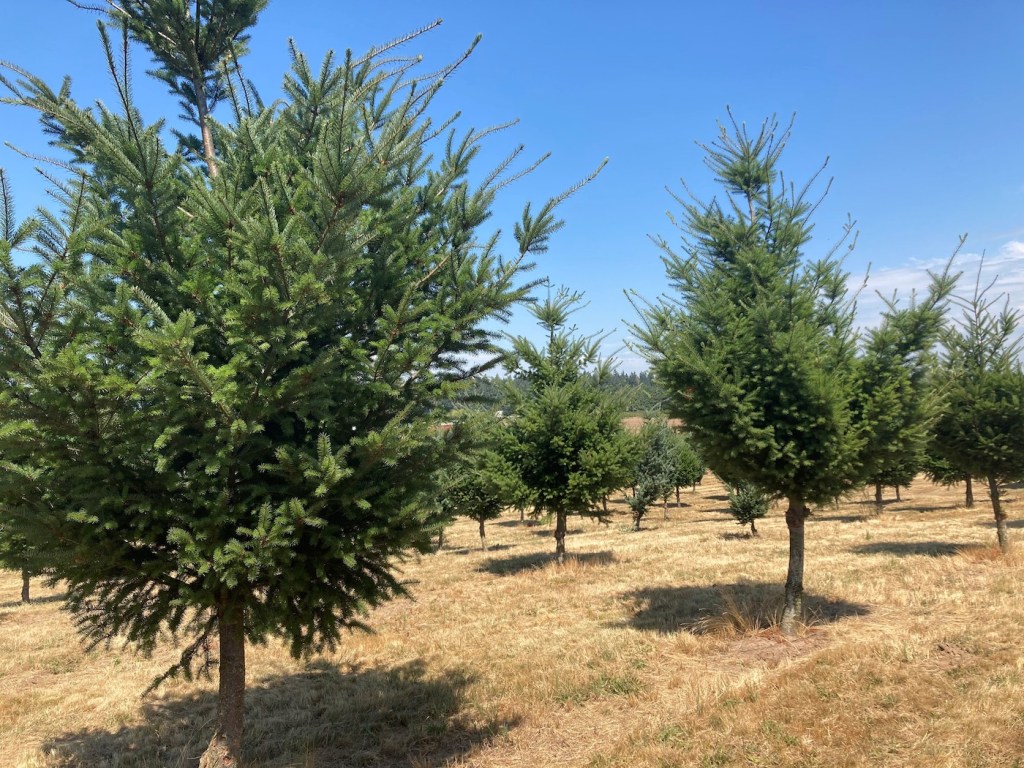Growing Christmas Trees In A Warming World
4:00 minutes

For those who celebrate Christmas, the decision over a Christmas tree can be hotly debated. For those who hold out for a real tree, there are dozens of species available for American consumers—catering to Douglas fir aficionados, Fraser fir fans, and Noble admirers. But climate change could soon affect the selection at a tree lot near you.
Chal Landgren, a Christmas tree specialist at Oregon State University, manages a program that for decades has bred and developed seedlings raised to become Christmas trees. Oregon is responsible for growing 25% of all Christmas trees in the country, but heatwaves and drought have made this future tenuous.
“My kind of anecdotal information is that between this summer and the heat dome, we probably lost 50% of the seedlings that were planted,” Landgren told Science Friday.

Christmas trees take ten years to grow into maturity—meaning a bad batch of seedlings this year will have a big impact on the industry in a decade. Therefore, researchers like Landgren are searching for ways to make Christmas trees more resilient.
While Douglas firs and Noble firs are native to Oregon, these trees are vulnerable to pests and climate change. A big trend in Christmas trees has been tree species sourced from Georgia and Turkey. These trees don’t get a lot of the diseases that plague native trees, and they’re more resilient to warmer, drier climates.
Researchers are also experimenting with growing methods. “We’ve also used mulch, just woodchips,” Landgren said. “That’s probably made a 30 percent improvement in survival. It seems simple, but it’s been working.”
SciFri producer Kathleen Davis went to Langren’s Christmas tree orchard in Aurora, Oregon over the summer to learn more about how growers are faring.
Invest in quality science journalism by making a donation to Science Friday.
Chal Landgren is a Christmas tree specialist at Oregon State University in Aurora, Oregon.
IRA FLATOW: If you celebrate Christmas, odds are good that you’ve acquired a Christmas tree or you’re planning to do so this weekend. Oregon is the largest producer of real Christmas trees in the country, responsible for about 25% of them.
Earlier this year, SciFri producer Kathleen Davis went to a Christmas tree farm in Aurora, Oregon, and checked out how the Christmas tree industry is changing, and the impact that increased heat and drought– climate change– are having.
KATHLEEN DAVIS: Chal Landgren may have one of the coolest job titles out there. He’s a Christmas tree specialist at Oregon State University. He manages a program that, for decades, has bred and developed seedlings that are raised to become Christmas trees. There are dozens of tree species that are used for the purpose of holding ornaments and lights. And Chal says there’s no easy answer as to which type is best.
CHAL LANDGREN: It’s kind of like asking, how do you pick a beautiful person? There’s lots of opinions. But some of the things that we look for in the breeding program are– you’ll notice that these trees are a darker color– so color, a dark dark gray or blue color– vertical branching. If you look at the Douglas fir behind you, you can see that straight up-and-down branching. That helps fill in a lot of holes on the side of trees for ornaments. And that color– we haven’t fertilized these trees ever, but you can get this dark blue color.
KATHLEEN DAVIS: And the needles are important, too. Christmas tree needles are the bane of vacuum cleaners everywhere. And Christmas tree breeders know this.
CHAL LANDGREN: You’d think you’d like big needles. But the testing that we’ve done with consumers, they tend to like small needles, bushy short. But all of these trees have been tested for needle loss. So we’ve run through some trials, where we’ve taken branches and measured the number of needles that fall off, and then bred in the ones that didn’t have significant needle fall after two weeks.
KATHLEEN DAVIS: Douglas firs and Noble firs are native to Oregon. But these trees are also vulnerable to pests. So a big trend in Christmas trees over the last decade is seedlings sourced from Georgia, the country, and Turkey. These Turkish, Nordmann, and Trojan trees don’t get a lot of the diseases that plague native trees.
CHAL LANDGREN: The other is that Turkish and Nordmann and Trojan do a lot better in these drier summers that we’ve been having. We’ve really struggled with dry summers, particularly for Noble fir, which is what’s growing out here.
KATHLEEN DAVIS: Like many parts of the country, the Pacific Northwest has been hit hard by heat and drought this past decade. This is bad news for Christmas trees, which take about 10 years to grow to proper size.
There was a big heat wave this summer in the Pacific Northwest, and Chal says that’s going to affect the trees 10 years from now.
CHAL LANDGREN: My anecdotal information is that, between the summer and the heat dome, we probably lost 50% of the seedlings that were planted.
KATHLEEN DAVIS: Again, these trees take 10 years to grow. So shortages will be felt in upcoming Christmases. That makes research on tree survival imperative. Chal and his team have been experimenting with adding different things to planting soil and trying out different fertilizers, really throwing things at the wall and seeing what sticks.
The most promising thing so far– mulch– just wood chips.
CHAL LANDGREN: And that’s made probably a 30% improvement in survival, just having the wood chips at the base of the trees. It keeps the heat down and a little bit more moisture in. It seems simple, but it’s been working.
KATHLEEN DAVIS: What’ll really help? Cooler summers and more rain. That may just need a Christmas miracle.
IRA FLATOW: That was SciFri producer Kathleen Davis reporting from Aurora, Oregon.
Copyright © 2022 Science Friday Initiative. All rights reserved. Science Friday transcripts are produced on a tight deadline by 3Play Media. Fidelity to the original aired/published audio or video file might vary, and text might be updated or amended in the future. For the authoritative record of Science Friday’s programming, please visit the original aired/published recording. For terms of use and more information, visit our policies pages at http://www.sciencefriday.com/about/policies/.
Kathleen Davis is a producer and fill-in host at Science Friday, which means she spends her weeks researching, writing, editing, and sometimes talking into a microphone. She’s always eager to talk about freshwater lakes and Coney Island diners.
Ira Flatow is the founder and host of Science Friday. His green thumb has revived many an office plant at death’s door.